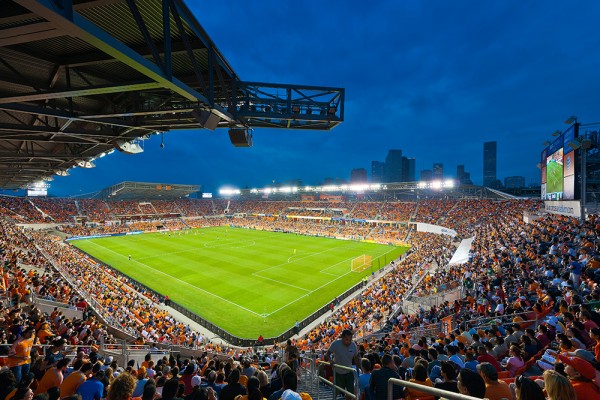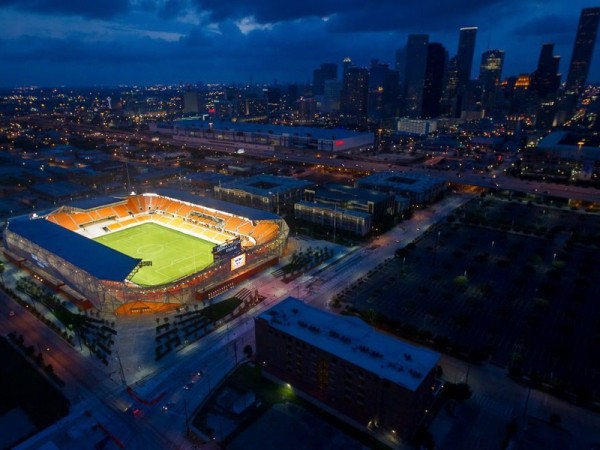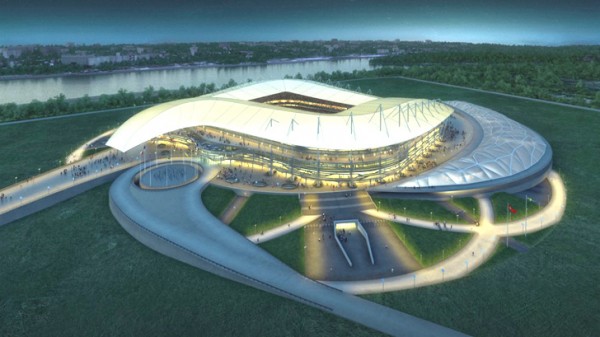The average sports stadium—with its blazing nighttime lights, high construction costs, thousands of disposable beer cups and acres of parking spaces—may not be the greenest of civic structures, especially when one considers how little it is used year-round. This reputation is beginning to change, though, as many new stadiums around the world are beginning to adopt LEED standards, including at least five Major League baseball parks and a few progressive NFL venues.
Today, as the regular NFL football season comes to a close, we take a look at the other sport of football (or futbol) to catch up on two soccer stadiums—BBVA Compass Stadium in Houston and the proposed World Cup 2018 stadium in Rostov-on-Don, Russia—that are lowering their overall carbon footprints with sustainable design. Both came from sports facility powerhouse Populous, which is responsible for dozens of other green stadium designs around the world.

After opening in May 2012 as the new home of the Houston Dynamo Major League Soccer team, BBVA Compass Stadium earned a LEED Silver certification for new construction earlier this month. The $60 million, 22,000-seat arena uses 41 percent less water and 20 percent less overall energy that conventional stadiums, according to BBVA statement.
Other green features in the Populous design include preferred parking spaces for low-emitting and fuel-efficient vehicles, low-water-use restroom fixtures and a recycling program called “Building a Better Planet,” which BBVA negotiated with Houston’s Greenstar Recycling firm. During construction, nearly 87 percent of the waste was diverted from landfills and more than 98 percent of the wood was sourced from forests certified by the Forest Stewardship Council.

To encourage the use of mass transit, the stadium limited parking to just 1,800 spaces and is also within walking distance of a future light rail stop currently under construction. The 12-acre site is also adjacent to Minute Maid Stadium, home of the Houston Astros baseball team, and the George R. Brown Convention Center, creating a walkable sports, events and tourism hub for the city.
On the other side of the world, Populous recently revealed its plans for the new Rostov Stadium, which will open in time for Russia to host the 2018 FIFA World Cup tournament in 12 locations across the vast country.

Unlike other stadiums that try to fit seamlessly into an urban setting, the design of the Rostov-on-Don facility will incorporate some natural and archaeological features of the nearby Don River landscape. The sinuous, rolling rooftop is inspired, Populous says, by the ancient burial mounds, called Kurgans, that are found along the banks of the river.

The 45,000-seat stadium (which will be scaled back to 25,000 seats after the tournament) will form the central core of a “green city project” to protect wetland areas to the south of the river. Populous designed the Rostov facility with a white, semi-transparent roof that will partially encircle the seating area, bringing in natural light while reflecting excess solar heat. The canopy will protect spectators from wind and rain, much like an enclosed facility, but will also be open on the sides, providing natural air circulation.
Besides the Rostov facility, Populous will design three other World Cup 2018 venues in Kazan, Saransk and Sochi. Populous also designed the stadium for the 2014 Sochi Winter Olympic Games.